Jul 18, 2025
Improving the safety of valve testing operations has become a priority for many organizations using hydraulic valve test benches. Recent design updates have introduced additional safety mechanisms designed to protect personnel, prevent equipment damage, and assist companies in maintaining compliance with recognized industry standards. This article describes key safety enhancements, explains how they work, and provides practical advice on how to effectively implement them.

Enhanced Pressure Control Systems
One of the notable updates in hydraulic valve test benches is the integration of improved pressure control system. Accurate pressure regulation is important to prevent sudden pressure surges that could cause a test failure or be dangerous to the operator.
Modern systems are now equipped with dual-stage pressure relief valves designed to respond to different pressure thresholds. When pressure exceeds the preset operating limit, the initial-stage pressure relief valve activates, gradually relieving the overpressure to prevent a sudden pressure release.The second-stage pressure relief valve activates only when the first-stage pressure relief valve is not sufficient to reduce the pressure, providing additional protection.
For operators, this means that unexpected overpressure events are less likely to escalate into emergency situations. Because the pressure relief process can be automated according to pre-configured parameters, the need for manual intUpgraded Clamping and Locking Mechanisms
Another major improvement involves the test bench’s clamping and locking systems. In many configurations, traditional mechanical clamps have been replaced with hydraulic locking cylinders and interlock safety devices.
These upgraded mechanisms allow operators to clamp valves securely with even force distribution. Hydraulic clamping helps minimize the risk of uneven pressure points that could cause leaks or mechanical stress during testing. Interlock safety features prevent the test cycle from starting if the clamps are not fully engaged, reducing the possibility of accidental loosening.
In practice, this helps maintain consistent sealing performance and supports a safer workflow when testing valves of different diameters and connection types.
Integrated Emergency Stop Controls
An increasing number of hydraulic valve test benches are equipped with multiple emergency stop controls in easily accessible locations around the equipment. This design enables operators to quickly shut down the feature if a problem arises.
Newer models often include both a physical emergency stop button and a digital touchscreen shutoff option. This dual approach ensures that operators can react quickly no matter where they are near the equipment or at what stage of the testing process they are in.
When evaluating whether to upgrade or replace an older test bench, consider whether the control panel has this flexibility. Clear labeling and regular training are equally important so that team members know how to initiate emergency stop functions as needed.
Real-time Monitoring and Alarm Capabilities
In addition to mechanical improvements, modern valve test stands are now equipped with digital monitoring tools that can track system parameters in real time. These systems continuously measure factors such as pressure, temperature, and flow and display the data on an easy-to-read interface.
If readings exceed specified thresholds, the system will sound an alarm, immediately alerting the operator. Some platforms can also trigger automatic shutdown procedures to help reduce the risk of damage or injury.
Recording these alarms in an electronic log helps improve traceability and allows companies to prove that they followed established procedures. It also provides useful information for troubleshooting recurring problems or identifying training needs.
Implementation Recommendations
Before adopting these enhanced safety features, plants should review their current valve testing processes to identify potential gaps. Begin by accessing whether the existing equipment provides adequate pressure control,clamping security,and emergency response options.
If deficiencies are found, consider whether to retrofit components or invest in a new test stand. Many manufacturers offer modular upgrades that allow companies to gradually enhance their systems without major disruptions to operations.
Operator training is another important part of successful implementation. Even the most advanced safety features require ongoing awareness and proper use to be effective. Establishing regular training sessions and refresher courses can help keep safety practices up to date.
Also document any changes to test protocols or equipment configurations. Clear records of maintenance activities, inspections, and employee training aid compliance and provide evidence of proactive risk management.
The latest safety improvements to hydraulic valve test benches reflect the company’s ongoing efforts to enhance operator protection and ensure consistent test results. By integrating enhanced pressure controls, advanced clamping systems, emergency shutdown mechanisms, and digital monitoring tools, the company can create a safer, more controlled environment for valve testing. Facilities planning to upgrade their valve testing capabilities should carefully evaluate their operational needs and consider these innovations as part of a broader strategy to improve safety and efficiency.ervention is also reduced.